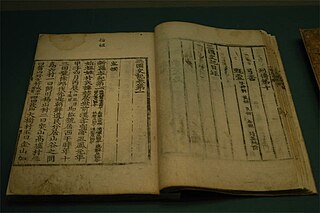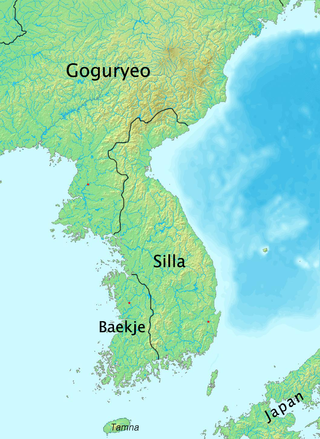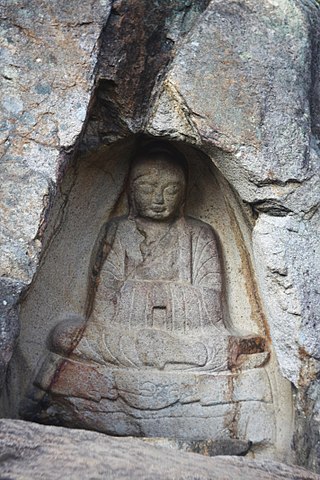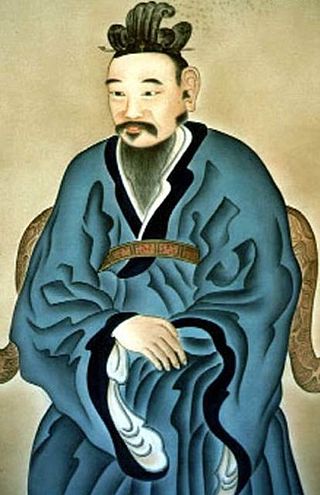
Samguk Sagi is a historical record of the Three Kingdoms of Korea:Goguryeo,Baekje,and Silla. Completed in 1145,it is well-known in Korea as the oldest surviving chronicle of Korean history.

Silla,was a Korean kingdom that existed between 57 BCE –935 CE and located on the southern and central parts of the Korean Peninsula. Silla,along with Baekje and Goguryeo,formed the Three Kingdoms of Korea. Silla had the lowest population of approximately 850,000 people,which was significantly smaller than those of Baekje and Goguryeo.

Samguk yusa or Memorabilia of the Three Kingdoms is a collection of legends,folktales and historical accounts relating to the Three Kingdoms of Korea,as well as to other periods and states before,during and after the Three Kingdoms period. "Samguk yusa is a historical record compiled by the Buddhist monk Il-yeon in 1281 in the late Goryeo Dynasty." It is the earliest extant record of the Dangun legend,which records the founding of Gojoseon as the first Korean nation. The Samguk yusa is National Treasure No. 306.
Hyeokgeose of Silla,also known by his personal full name as Bak Hyeokgeose (朴赫居世),was the founding monarch of Silla,one of the Three Kingdoms of Korea. He was the progenitor of all Bak (Park) clans in Korea.

Queen Seondeok of Silla reigned as Queen Regnant of Silla,one of the Three Kingdoms of Korea,from 632 to 647. She was Silla's twenty-seventh ruler,and its first reigning queen. She was the second female sovereign in recorded East Asian history and encouraged a renaissance in thought,literature,and the arts in Silla. In Samguksagi,Queen Seondeok was described as "generous,benevolent,wise,and smart". According to the Legend of Jigwi,she was also beautiful. She developed Buddhist culture,selected great talent,and established diplomacy with the Tang dynasty,laying the foundation for the unification of the Three Kingdoms of Korea. Queen Seondeok is known as a wise and kind monarch,making her one of the most prominent monarchs in Korean history.

Kim Yu-sin the great was a Korean military general and politician in 7th-century Silla. He led the unification of the Korean Peninsula by Silla under the reign of King Muyeol and King Munmu. He is said to have been the great-grandchild of King Guhae of Geumgwan Gaya,the last ruler of the Geumgwan Gaya state. This would have given him a very high position in the Silla bone rank system,which governed the political and military status that a person could attain.

Suro (수로) or Sureung,commonly called Kim Suro,was the legendary founder and Hero King of Geumgwan Gaya (43–532),in southeastern Korea.

Ch'oe Ch'i-wŏn was a Korean philosopher and poet of the late medieval Unified Silla period (668-935). He studied for many years in Tang China,passed the Tang imperial examination,and rose to the high office there before returning to Silla,where he made ultimately futile attempts to reform the governmental apparatus of a declining Silla state.
Yuri of Silla was the third king of Silla,one of the Three Kingdoms of Korea. He is commonly called Yuri Isageum.
Talhae of Silla was the fourth king of Silla,one of the Three Kingdoms of Korea. He is commonly called Talhae Isageum,isageum being the royal title in early Silla. Also known by his personal name as Seok Tal-hae (昔脫解).
Adalla of Silla was the eighth ruler of Silla,one of the Three Kingdoms of Korea. He is commonly called Adalla Isageum,isageum being the royal title in early Silla. As a descendant of Silla's founder Hyeokgeose,his surname was Bak.
Kim In-mun was a noted aristocrat,scholar,and official of the ancient Korean kingdom of Silla. He was the son of Muyeol and the younger brother of Munmu,the twenty-ninth and thirtieth kings respectively of Silla.

Heongang of Silla (c.861–886),personal name Kim Chŏng,was the 49th to rule the Korean kingdom of Silla.
Kim Al-chi,was a historical figure in Korean history. His descendants formed the Kim royal clan of Silla,one of the Three Kingdoms of Korea.
Lady Saso is said to be the mother of Hyeokgeose of Silla first introduced in Samguk Yusa. Also known as the Sacred Mother of Mt. Seondo,legends say she was a princess from the Buyeo royal family. She gave birth to Hyeokgeose of Silla. Later,she was honored as great king by King Gyeongmyeong.
Lady Aryeong was married to Hyeokgeose of Silla who was the founder of Silla. According to Samguk Yusa,Aryeong was born from the left side of the dragon which appeared near the well. However,the Samguk Sagi,says it was the right side.

The Gyerim Territory Area Command was a proposed autonomous administration to be established in Silla territory by the Tang dynasty. In the place of Baekje and Goguryeo,the Tang created the Protectorate General to Pacify the East,Ungjin Commandery.
Korean clans of foreign origin refers to Korean clans that claim descent from a progenitor of foreign origin,based on genealogical records.
Queen Jaui or Queen Janul,of the Gyeongju Kim clan,was a Korean queen consort. She was the spouse of king Munmu of Silla. She was a first cousin once removed of Queen Seondeok and Princess Cheonmyeong.
The Wolseong Seok clan,also known as the Gyeongju Seok clan is a Korean clan. Their Bon-gwan is in Gyeongju,North Gyeongsang Province. It was founded by Seok Jae-heung (昔載興),a descendant of Seok Tal-hae the 4th monarch of the korean ancient kingdom of Silla. The Seok clan was one of the three clans that shared and ruled the Silla throne during its early period.












